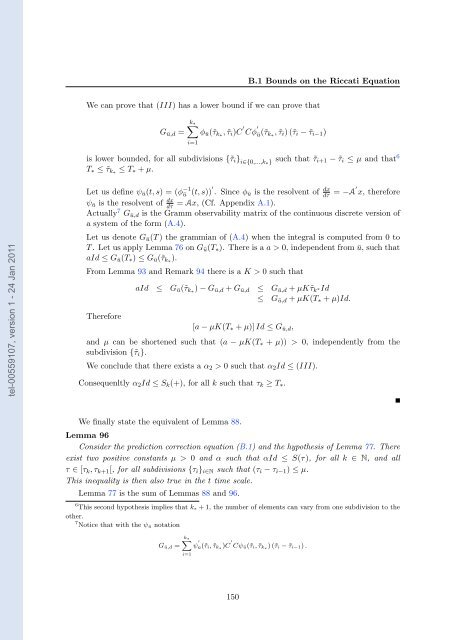Adaptative high-gain extended Kalman filter and applications
Adaptative high-gain extended Kalman filter and applications
Adaptative high-gain extended Kalman filter and applications
Create successful ePaper yourself
Turn your PDF publications into a flip-book with our unique Google optimized e-Paper software.
tel-00559107, version 1 - 24 Jan 2011<br />
We can prove that (III) has a lower bound if we can prove that<br />
k∗ �<br />
Gū,d =<br />
i=1<br />
B.1 Bounds on the Riccati Equation<br />
′<br />
φū(˜τk∗ , ˜τi)C Cφ ′<br />
ū(˜τk∗ , ˜τi) (˜τi − ˜τi−1)<br />
is lower bounded, for all subdivisions {˜τi} i∈{0,...,k∗} such that ˜τi+1 − ˜τi ≤ µ <strong>and</strong> that 6<br />
T∗ ≤ ˜τk∗ ≤ T∗ + µ.<br />
Let us define ψū(t, s) =(φ −1<br />
ū (t, s)) ′<br />
. Since φū is the resolvent of dx<br />
dτ<br />
= −A′ x, therefore<br />
ψū is the resolvent of dx<br />
dτ = Ax, (Cf. Appendix A.1).<br />
Actually7 Gū,d is the Gramm observability matrix of the continuous discrete version of<br />
a system of the form (A.4).<br />
Let us denote Gū(T ) the grammian of (A.4) when the integral is computed from 0 to<br />
T . Let us apply Lemma 76 on Gū(T∗). There is a a>0, independent from ū, such that<br />
aId ≤ Gū(T∗) ≤ Gū(˜τk∗ ).<br />
From Lemma 93 <strong>and</strong> Remark 94 there is a K>0 such that<br />
Therefore<br />
aId ≤ Gū(˜τk∗ ) − Gū,d + Gū,d ≤ Gū,d + µK˜τk ∗Id<br />
≤ Gū,d + µK(T∗ + µ)Id.<br />
[a − µK(T∗ + µ)] Id ≤ Gū,d,<br />
<strong>and</strong> µ can be shortened such that (a − µK(T∗ + µ)) > 0, independently from the<br />
subdivision {˜τi}.<br />
We conclude that there exists a α2 > 0 such that α2Id ≤ (III).<br />
Consequenltly α2Id ≤ Sk(+), for all k such that τk ≥ T∗.<br />
We finally state the equivalent of Lemma 88.<br />
Lemma 96<br />
Consider the prediction correction equation (B.1) <strong>and</strong> the hypothesis of Lemma 77. There<br />
exist two positive constants µ > 0 <strong>and</strong> α such that αId ≤ S(τ), for all k ∈ N, <strong>and</strong> all<br />
τ ∈ [τk, τk+1[, for all subdivisions {τi}i∈N such that (τi − τi−1) ≤ µ.<br />
This inequality is then also true in the t time scale.<br />
Lemma 77 is the sum of Lemmas 88 <strong>and</strong> 96.<br />
6 This second hypothesis implies that k∗ + 1, the number of elements can vary from one subdivision to the<br />
other.<br />
7 Notice that with the ψū notation<br />
Gū,d =<br />
k∗�<br />
i=1<br />
ψ ′<br />
ū(˜τi, ˜τk∗)C ′<br />
Cψū(˜τi, ˜τk∗) (˜τi − ˜τi−1) .<br />
150

















